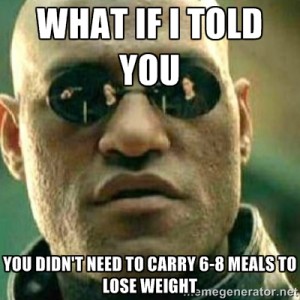Consuming meals in a habitual style where you eat every 2-3 hours or so, is a popular talked-about and promoted method for losing pounds, getting your shred on, and even adding and maintaining musclez.
But, is there any actual merit to it? Or is it just another one of those things people do in a blind sheep sorta way?
EVERY 2-3 hours.
Oh man, that is a stressful thing to complete, right? Every two to three hours. I’ve even heard of people setting alarms on their phones to remind them to eat.

Let’s look at it from a survival standpoint initially.
It would indeed seem kinda extreme that we’d have to eat every two to three hours just to keep our hard-earned muscle mass, keep our metabolic rate from declining in speed or even lose those last few grams to get up on stage, right?
It’s also a pretty impossible/annoying task to sustain when you add in that ‘life’ thing we do everyday. Since, for a lot of people, they simply don’t have enough time to drop everything they’re doing and pick up a fork. Sound familiar?
To “stoke your metabolic fire” and “keep your metabolism running high” are two things that gets thrown into the mix in regards to eating every 2-3 hours. But it really is some serious bullshit [1-3].
I really do honestly feel sorry for the people that lug 6+ Tupperware containers around to work, school, or even to their friends BBQ.

Let’s get into the why with a little bit of science and… Maths. Ugh.
TEF.
So, each time we consume foods (including alcohol), our body immediately burns calories from the process of digestion/absorption/distribution. This is known as the thermic effect of food [4-12] or, TEF (yep, yet another acronym to add to your brainz).
Each of the macronutrients responds differently in each of us and to the amount we eat. But roughly speaking, for each 100 calories consumed, the breakdown is around [13]:
- Protein – 20-25%
- Carbohydrates – 4-7%
- Fibrous carbohydrates – 15-20%
- Fats – 3-4% 243
- Alcohol – 15-20%
Now let’s say we eat a meal consisting of 500g of chicken breast (grilled), 1100g of white rice and around 400g of broccoli buds.
Huge meal, yep. But we’ll be using this one again later on to make this even easier to understand.
So, in this meal we’d be getting around 300g of protein, 280g of carbs (with around 10 of these being fibrous) and 27g of fats totaling around 2600 calories (you can do the math if you like). Deal?
By calculating with the over percentages, we’d be burning around 310ish calories just from consuming this overall pretty tasteless meal (definitely needs cheese or soy sauce or something).
Pretty cool.
But the TEF is definitely a very minor detail when it comes to working out our overall intake.
And not to mention, I don’t see too many/any people actually calculating each of their meals to see the TEF breakdown. But hey, it still does count.
The theory.
So every time we eat, our metabolic rate (MR) goes up a little bit due to the TEF.
This is where the every 2-3 hours theory comes from.
The thought process is if we have a spike in our MR every time we eat, then eating more often should constantly give us more spikes, and therefore help us to lose more weight, right?
Wrong!
Well, in some ways, kinda. But let me explain before you hit the ‘exit window’ button on this one and head to the kitchen to rearrange your Tupperware.

Meal TEF.
Let’s now reintroduce that above meal we talked about earlier (consisting of the 500g chicken, 1100g of white rice and 400g of broccoli).
But let’s firstly round the 310ish calories we initially got from the TEF to a nice even 300.
Since we know that we’d be burning around 300 calories after that 2600 calorie meal just from the TEF, let’s now break the entire meal up into the “recommended” six meals for weight loss/gain.
This brings each meal to a total of around 400 calories. (Again, you can do the math if you like.)
But let’s also make things interesting by splitting the 2600 calorie meal up into just the “standard” breakfast, lunch and dinner meal combo (ie. three meals).
This equaling close to 900 calories per meal ingested.
Six meals: ~400 calories.
Three Meals: ~900 calories.
Results:
After some calculations, from each of the six meals we’d be burning around 50 calories from the TEF.
And with the three meals we’d be burning around 100 calories.
Judging by that we can see that it’s around a 9-10% burn every time we consume a meal, right?
Now for the crazy part.
Let’s now multiply the six “recommended” meals by the 50 or so TEF calories burned.
6 x 50 cal = 300.
And now we multiply the three “standard” meals by the 100 or so TEF calories.
3 x 100 cal = 300.
Yep, that’s right. 300 also.
Exactly the same amount is burned when we split up the meals (either into three or six) or simply just consume the entire 2600 calorie meal in one sitting.
I dunno about you, but I definitely would prefer to eat more satisfying meals (ie. the three meals) than six smaller sized meals when I’m trying to lose weight.
But hey, that’s just me.
It does make the whole “constantly spike your metabolism by consuming constant meals” seem kinda stupid now, right?
Not convinced?
So wait, “why am I hungry every 2-3 hours then?”, you ask?
Simple answer.
But we will go into that and more in depth next week!
See y’all then.
[REFERENCES.]


